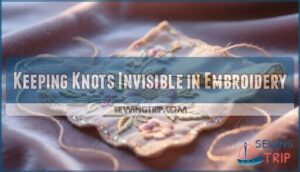This site is supported by our readers. We may earn a commission, at no cost to you, if you purchase through links.

This trusty knot won’t slip through fabric and stays put like a faithful friend.
For finishing seams, use a locking stitch instead since it hides within the seam without creating lumps.
Quilting projects call for quilting knots that disappear between layers.
Heavy fabrics can handle double-thread knots for 30% more strength, while delicate materials need gentler approaches.
The secret isn’t memorizing dozens of knots – it’s matching the right technique to your fabric and purpose.
Master these basics first, then discover the game-changing methods that’ll transform your stitching from amateur to artisan.
Table Of Contents
Key Takeaways
- Master the tailor’s knot first – You’ll use this reliable technique for most hand-sewing projects since it won’t slip through fabric and provides secure anchoring for your stitches.
- Match your knot to your fabric weight – You’ll need sturdy double-thread knots for heavy materials like denim, but delicate fabrics require gentler quilting knots that won’t show through.
- Use locking stitches to finish seams – You’ll get professional results by creating tiny backstitches that form secure loops instead of bulky knots at seam ends.
- Hide knots within seam allowances – You’ll achieve clean, professional-looking projects by positioning knots between fabric layers where they won’t be visible from the right side.
Essential Knots for Hand Sewing
You’ll need different knots for different sewing situations, and mastering just a few essential ones will handle most of your hand-sewing projects.
Whether you’re starting a seam, finishing embroidery, or working with tricky fabrics like felt, the right knot keeps your stitches secure and your work looking professional.
The key to successful hand-sewing is understanding that the right knot is crucial for keeping your stitches secure.
Tailor’s Knot Basics
Why struggle with loose threads when mastering the tailors knot gives you perfect knot security every time?
This foundational sewing knot prevents thread from pulling through fabric by creating a compact, reliable anchor. Simply wrap thread around your needle twice, pinch the wraps, then pull the needle through to form your knot.
Master the tailor’s knot once—secure stitches become second nature, transforming amateur sewing into professional craftsmanship.
This essential knot tying technique guarantees proper thread tension while maintaining sewing basics across any fabric choice you’re working with.
Understanding proper thread management techniques is vital for achieving secure and reliable knots in hand sewing, and is a key part of mastering the basics.
Quilting Knot for Secure Starts
Mastery in quilting knots starts with creating a secure loop that won’t slip through your fabric.
You’ll wrap your needle with thread two to three times, then gently slide the bundle off while pinching it tight. This quilting basics technique gives you excellent thread control and stitch security.
Practice this sewing knot technique until tie knots become second nature—your quilting projects will thank you!
Understanding the proper use of a quilting knot tool is essential for achieving professional results.
Locking Stitch for Finishing Seams
The locking stitch gives you rock-solid seam security without bulky knots.
You’ll create this by making a tiny backstitch through both fabric layers, then passing your needle through that same stitch to form a secure loop.
Here’s your three-step process:
- Make a small backstitch at your seam’s end
- Insert needle through the same hole to create a loop
- Pull thread through loop until it flattens against fabric
This knotting technique keeps your thread tension even while providing superior fabric finishing.
The locking stitch stays hidden within your seam allowance, making it perfect for professional-looking results.
Double Thread Vs. Single Thread Knots
You’ll want to choose between double threaded needle and single threaded needle knots based on your project’s needs.
Double threaded knots offer superior knot strength and thread durability, withstanding 30% more tension than single thread options.
They’re perfect for high-stress seams and thick fabric choice like denim.
Single knots work faster, improving sewing speed for lightweight embroidery work where knot security isn’t critical.
Knots for Different Fabrics
When sewing different fabrics, matching knot techniques to fabric weight makes your projects stronger.
Lightweight fabrics like chiffon need tiny quilting knots that won’t show through.
Heavy materials like denim require sturdy tailor’s knots for knot security.
Stretchy knits work best with locking stitches that move with the fabric.
Choose your sewing knots wisely—the right knot strength keeps seams intact!
What Knot to Tie When Sewing
Choosing the right knot for your sewing project isn’t as tricky as you might think, but it makes all the difference between stitches that hold tight and seams that fall apart.
You’ll want different knots for starting your thread, finishing seams, and working with various fabrics—and once you master these basics, your sewing will look more professional and last much longer.
Step-by-Step Tailor’s Knot
Creating the perfect tailors knot starts with proper Thread Management – your foundation for Knot Security in Hand Stitching.
Hold your thread tail against the needle, leaving half an inch hanging like a tiny flag.
Wrap the working thread around your needle two to three times – more wraps mean a bigger knot for thicker fabrics.
Pinch those wraps gently, slide them toward the needle’s eye, then off completely.
Pull the knot to your thread’s end.
These basic sewing knot techniques and knotting techniques guarantee your Sewing Basics stay rock-solid, giving you those essential Tailor Tips for professional results.
How to Tie a Quilting Knot
Quilting knots offer rock-solid security for hand stitching projects. Unlike basic knots that might slip through delicate fabrics, this technique creates a sturdy anchor that won’t budge.
You’ll find it perfect for binding work and detailed quilting where thread management matters most.
- Create a loop by wrapping thread around your needle twice
- Hold the thread tail firmly to prevent slipping during formation
- Insert needle through the loop and pull gently to tighten
- Slide the knot down to thread’s end for proper positioning
- Practice on scrap fabric to master this essential quilting basics skill
This sewing knot technique transforms your tying off game. The wrap-around method gives you knot security that regular granny knots can’t match.
When you’re preparing fabric for quilting projects, having reliable knotting techniques in your toolkit makes all the difference. Your sewing tools work better when you start with confidence, knowing your stitches won’t come undone halfway through your masterpiece.
Using a Locking Stitch to End Seams
Security becomes your seam’s best friend with locking stitches.
Make a tiny stitch through both fabric layers at your seam’s end, then reinsert your needle through the same spot to create a loop.
Pass your needle through this loop and pull until it flattens against the fabric.
This knotting method provides excellent stitch reinforcement without bulky knots, though it’s visible when fabric binding stretches flat, using a technique that offers excellent stitch reinforcement.
Best Knots for Embroidery and Decorative Work
Embroidery knots require different techniques than regular sewing knots.
French knots create raised, bead-like effects perfect for flower centers—wrap thread 2-3 times around your needle for best results.
Colonial knots offer symmetrical texture for filling areas, while bullion knots form elegant coils ideal for stems.
Choose medium-twist threads and practice proper tension to prevent fabric puckering in your decorative stitches.
Mastering basic sewing knots, such as the granny knot techniques, is essential for creating secure and durable embroidery pieces that have elegant designs.
Step-by-Step Knot Tying Techniques
You’ll master these four essential knot-tying techniques in no time, turning frustrating thread tangles into neat, secure finishes.
Each method offers a unique approach to creating strong knots that’ll keep your stitches locked in place, whether you’re mending a favorite shirt or starting your first quilting project, using complete concepts to ensure a professional finish.
Wrap-Around-the-Needle Knot Method
The wraparoundtheneedle knot offers quick knot formation with excellent thread tension control. Simply wrap your thread around the needle five to six times, then pinch the loops and pull them off toward the thread end.
This sewing knot technique delivers reliable knot security through proper needle wrapping, making it perfect for maintaining sewing precision. Understanding the wrap knot techniques is essential for mastering this method.
- Speed demon: This method lets you tie knots faster than your favorite TV show’s commercial break
- No-slip grip: Those wrapped loops create a knot so secure, it won’t budge during even the toughest stitching sessions
- Beginner-friendly: Even if you’re all thumbs, this knotting method practically ties itself once you get the hang of it
Wrap-Around-Your-Finger Technique
Why struggle with complex knot methods when you can master this simple technique?
Pinch your thread end between thumb and forefinger, then wrap it around your finger two to three times.
Roll the wrapped thread off your finger with your opposite hand, then pinch the thread wreath and pull it away from the needle—it’ll form a perfect knot.
This wraparoundyourfinger knot offers excellent thread control and knot security, making it a favorite among sewers seeking reliable sewing tips for their projects.
Granny Knot for Hand Sewing
The granny knot offers simplicity but comes with trade-offs in knot security. While quick to tie, this basic technique works best for temporary holds and light sewing basics rather than permanent seams.
The method involves a few simple steps:
- Loop thread end over itself and pull through
- Repeat once or twice for better thread tension
- Perfect for button sewing and quick repairs
- Avoid on slippery fabrics or high-stress areas
This hand stitching method shines in sewing knot tutorials as a beginner-friendly option. However, fabric choice matters—loose weaves need extra repetitions. For reliable knotting basics in hand sewing, consider upgrading to more secure sewing knot methods when durability counts. Mastering the hand sewing knots technique is essential for creating sturdy and long-lasting seams.
Forming a Loop Knot Stitch
When you create a loop knot stitch, you’re securing your thread with a neat finishing technique that won’t pull through fabric.
Make a tiny stitch through both fabric layers, then reinsert your needle through the same spot to form a thread loop.
Pass your needle through this loop and pull tight until it flattens against the fabric for excellent stitch security and thread control.
How to Hide Knots in Sewing Projects
Nothing ruins a perfect sewing project like visible knots sticking out where they shouldn’t be.
You’ll learn four simple methods to hide your knots so well that even your grandmother won’t spot them lurking in your seams.
Concealing Knots in Seams
Properly tucked knots make your seams look professional instead of messy.
Start by positioning your knot within the seam allowance before stitching. After completing your seam, use sharp fabric scissors for precise thread trimming near the knot.
When working with thick fabrics, gently manipulate the material to bury knots deeper between layers. These invisible ties create clean finishes that won’t show when your project gets turned right-side out.
Hiding Knots in Quilting and Binding
Quilting knots need special attention to stay invisible.
Start your stitch by burying the knot between fabric layers – it’s like tucking a secret into your quilt sandwich.
For binding, use the wrap-around-needle technique to create small, tight knots that won’t show through.
These sewing hacks guarantee your quilting techniques and fabric finishing look professional every time.
Mastering the quilter’s knot technique is essential for a polished finish in quilting projects.
Techniques for Felt and Thick Fabrics
Thick fabrics like felt demand special knotting methods to keep your work looking professional.
When starting felt seams, bury your knot between fabric layers by inserting the needle through the middle—this hides the bulk perfectly. For secure stitches, wrap thread around your needle three times before pulling through; thick fabric needs larger knots to prevent pull-through.
After finishing, thread your needle back into the same exit point and run it under the surface about an inch before trimming. This thread management technique keeps hidden threads invisible while maintaining sewing knot strength.
For beginners, using felt sewing kits can be very helpful in practicing these techniques.
Keeping Knots Invisible in Embroidery
Embroidery projects showcase your artistry, so visible knots can ruin the magic. Smart thread concealment keeps your work looking professional from every angle.
Here’s how to master invisible stitches in embroidery:
- Start beneath the fabric – Insert your needle from the back, leaving a small tail that you’ll catch with your first few stitches
- Use the waste knot method – Tie a temporary knot, stitch over the thread path, then snip the knot away
- Weave through existing stitches – Run your thread under completed embroidery work to anchor without knotting
- Create tiny backstitches – Make microscopic stitches in areas that’ll be covered by future embroidery
- Hide in seam allowances – When possible, position your tying off points where fabric finishing will conceal them
These embroidery tricks transform messy thread ends into seamless fabric finishing that won’t unravel.
Tips for Secure and Neat Finishing
You’ll want to tie knots that stay put without causing problems later—nobody likes discovering their careful work has unraveled after a few wears.
Getting the right balance between secure and neat takes a bit of practice, but once you nail these finishing techniques, your sewing projects will look professional and last for years.
Importance of a Firm Knot
Once you’ve mastered hiding knots, you’ll quickly discover that knot security makes or breaks your entire project.
A loose knot is like a weak link in a chain—it’ll fail when you need it most.
Your thread tension and stitch strength depend on firm knotting techniques that protect fabric integrity and guarantee sewing durability.
| Knot Type | Security Level | Best Use |
|---|---|---|
| Tailor’s Knot | High | Heavy fabrics, button attachment |
| Quilting Knot | Medium-High | Hand quilting, binding work |
| Granny Knot | Medium | Light fabrics, temporary fixes |
Avoiding Fabric Puckering
Beyond proper knotting, sewing knot techniques require smart tension control to prevent fabric puckering.
Choose fine threads and match needle size to your fabric choice—oversized needles create holes that cause distortion.
Maintain gentle, even thread tension while stitching, and use shorter stitch lengths for smoother seams.
Position knots within the seam allowance where bulk won’t show through, ensuring a clean finish with proper knotting.
Ensuring Durable Seams
Strong sewing knots create seams that won’t unravel over time. Your thread selection and stitch density work together like a team—choose quality thread that matches your fabric weight, and maintain consistent tension control throughout your project.
Here are five ways to build bulletproof seams:
- Double-knot heavy fabrics for extra holding power
- Test thread strength before starting large projects
- Match stitch density to fabric thickness
- Control thread tension to prevent breaking
- Reinforce stress points where seams meet
Seam reinforcement isn’t just about knot security—it’s about understanding how your fabric choice affects durability and adjusting your sewing techniques accordingly.
Practice and Consistency in Knot Tying
Like learning to ride a bike, knot tying improves with repetition and muscle memory.
Start with simple sewing drills—tie ten tailors’ knots daily to build hand dexterity and thread control.
Focus on consistent knot tension; loose knots unravel while overly tight ones pucker fabric.
Master basic sewing knot techniques before advancing to complex stitches.
Remember, stitch mastery comes from patience, not perfection—even seasoned sewers occasionally fumble their knot guide!
Frequently Asked Questions (FAQs)
How to know which tie knot to use?
Ironically, choosing the right knot isn’t rocket science—it’s simpler than you’d think!
Use tailor’s knots for general hand sewing, granny knots for quick fixes, and loop methods when you can’t tie knots easily.
Are there any alternative methods to tying knots in sewing?
You can skip knots entirely by using the loop method – make a tiny stitch, create a loop, pass your needle through, and pull tight.
This secures thread invisibly within seam allowances without bulky knots.
What is the best knot-tying technique for machine stitching?
Machine stitching doesn’t require knots at all – your sewing machine handles thread securing automatically.
You’ll simply backstitch at seam beginnings and ends, letting those reverse stitches lock everything in place perfectly.
What happens if I dont tie knots when sewing?
Without proper knots, your stitches will unravel and fall apart.
Seams won’t hold, hems will come undone, and buttons will pop off.
You’ll end up with loose threads everywhere and garments that basically fall to pieces, which can be summarized as a result of poor knots.
Why do my knots come undone during washing?
Your knots are probably staging a great escape because they’re too loose or you’re using the wrong technique.
Weak knots can’t handle the washing machine’s aggressive spin cycle.
Try the tailor’s knot – wrap thread around your needle three times, then pull tight.
This creates a stronger, bulkier knot that won’t slip through fabric or unravel during wash cycles.
When is it acceptable to skip knots altogether?
You can skip knots when using serged seams, French seams, or flat-fell seams where raw edges are enclosed.
Also skip them for basting stitches you’ll remove later or when backstitching securely locks thread ends.
Conclusion
Practice makes perfect when mastering what knot to tie when sewing.
You’ve learned the essential techniques that’ll transform your projects from basic to beautiful.
Start with the trusty tailor’s knot for everyday sewing, then branch out to quilting knots and locking stitches as your confidence grows.
Remember, the right knot choice depends on your fabric and project goals, and keep practicing these fundamentals, and soon you’ll tie knots without thinking twice about it, with the right knot choice becoming second nature.















